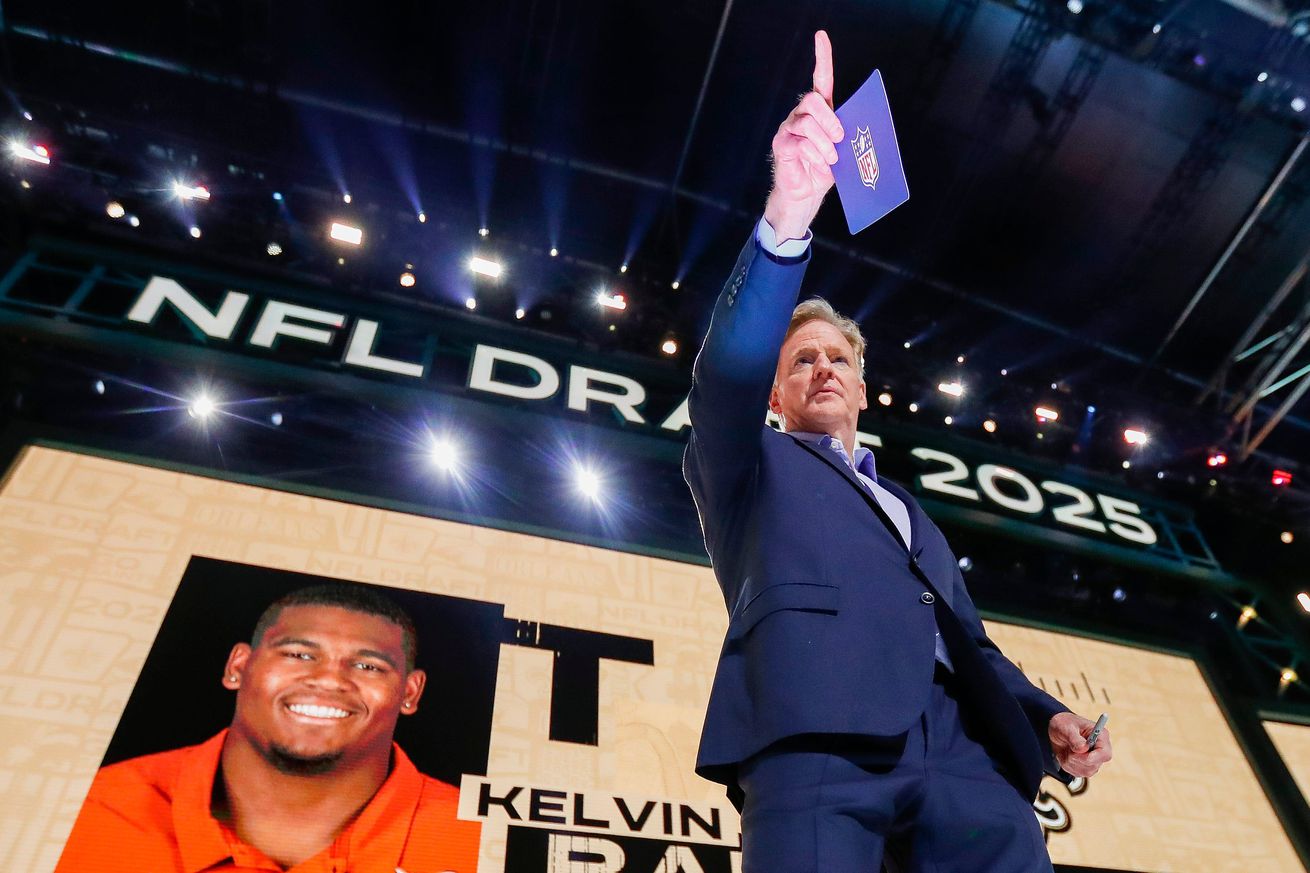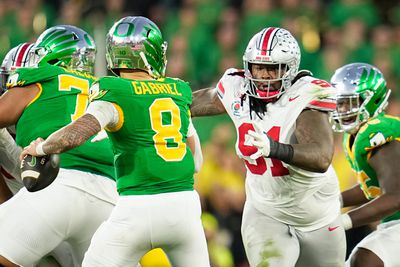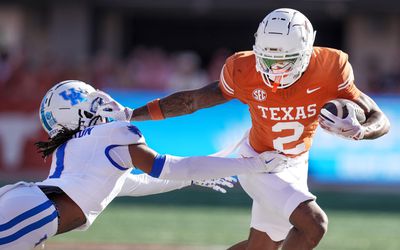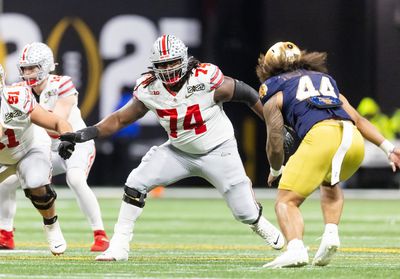
With the 2025 NFL Draft in the rearview mirror, it’s time to check in on the best division in football from a year ago. Who had the best haul, and how much will this change the complexion of the division over time?
The NFL Draft process is always interesting to monitor. The lead-up typically starts in May, but most don’t start paying attention until the middle of the college season. For fans of bad teams, they might start paying attention as soon as October, in anticipation of the following offseason. Most NFL fans won’t begin to dive into players until after the new year. The combine and Pro Days fly by, while taking a back seat to the initial wave of free agency. Then, draft weekend comes out of nowhere and is over just as quickly as it started.
Just months after sending three teams to the playoffs, most of the NFC North drafted in the mid-20s. After finishing 5-12, the Chicago Bears were the only exceptions in one of the best regular-season divisions in football. Despite each team having different goals, the focus on the trenches was common for all four teams. The Detroit Lions added two more high-caliber offensive linemen to one of the league’s top units. Despite the speculation surrounding cornerback Jaire Alexander, the Green Bay Packers didn’t select a cornerback until the seventh round. Despite the Minnesota Vikings’ lack of draft capital, they found a way to continue their interior offensive line overhaul.
Each team had a goal in mind, and if you listened to all four general managers, they’d claim to have accomplished their goals. With the dust settling from an ever-busy weekend in Green Bay, it’s time to dive deeper into each team’s draft class and how the NFC North looks heading into the offseason programs.

Joe Nicholson-Imagn Images
Chicago Bears
Round 1 (#10): TE Colston Loveland (Michigan)
Round 2 (#39): WR Luther Burden III (Missouri)
Round 2 (#56): OT Ozzy Trapilo (Boston College)
Round 2 (#62): DL Shemar Turner (Texas A&M)
Round 4 (#132): LB Ruben Hyppolite (Maryland)
Round 5 (#169): CB Zah Frazier (UTSA)
Round 6 (#195): iOL Luke Newman (Michigan State)
Round 7 (#233): RB Kyle Monangai (Rutgers)
Biggest Pre-Draft Needs: RB, DE, OT, LB, and S
Way Too Early Grade: B
No team in the NFC has seen more drastic changes this offseason than the Bears. After firing former head coach Matt Eberflus mid-season, Chicago landed their top target all along in offensive guru Ben Johnson. After assembling his coaching staff, general manager Ryan Poles and Johnson went to work on the offensive line. After landing three new starters on the interior and a pair of upgrades on the defensive line, they were able to go into the draft wide open.
Despite being rumored as a team expecting to take one of the top running backs in a historically deep class, they waited until the seventh round to add to that room. The primary focus early in the draft was on the offensive side of the ball. They opted for Loveland over Tyler Warren, then, after missing out on TreVeyon Henderson going one pick before them, they pivoted to Burden at receiver. Trapilo was the final piece to the offensive puzzle with the second pick in Round 2.
Poles and Johnson said they expected to draft three, maybe four, impact players in this draft, and they accomplished that on paper. Even so, it’s hard to feel too good when they all but ignored their two most significant needs at edge rusher and a top-tier running back. We’ll see if any of the remaining free agents on the market will bring some clarity.
Favorite Pick (Non-First Round): WR Luther Burden III (Missouri)
The Bears quickly pivoted to their next best option after losing out on both Ohio State running backs. Burden’s production in his junior season wasn’t nearly as impressive as it was in 2023, but his ability to make plays in the open field has to make head coach Ben Johnson feel giddy. The Bears had bigger needs on their roster than another top-end receiver, but as general manager Ryan Poles said multiple times through the weekend, they followed their board, leading them to a great value pick at No. 39 overall.
Riskiest Pick: LB Ruben Hyppolite (Maryland)
Heading into the draft, the Bears were not slated to pick in the fourth round. Thanks to their trade down from No. 41 overall, they were able to upgrade one of their seventh-round selections for No. 109. After once again missing on a pair of running backs, they chose to trade down. Despite considerably better talent on the board (according to the consensus board), they took Hyppolite, who most had as an undrafted free agent. This is a head-scratching pick at No. 401 on the consensus board.
Pick That Could Surprise: CB Zah Frazier (UTSA)
Coming in at 6’3 and running a sub-4.4 40-time, Frazier is one of the more interesting Day 3 prospects to be drafted. He got a late start to football and will be on the older side heading into his rookie season. Even so, his physical tools, combined with a six-interception senior season, caught the eye of well-respected defensive backs coach Al Harris in February. Considering how deep the team’s depth chart is at the position, Frazier will have time to develop before being asked to contribute much.

Adam Cairns/Columbus Dispatch / USA TODAY NETWORK via Imagn Images
Detroit Lions
Round 1 (#28): DT Tyleik Williams (Ohio State)
Round 2 (#57): iOL Tate Ratledge (Georgia)
Round 3 (#70): WR Isaac TeSlaa (Arkansas)
Round 5 (#171) iOL Miles Frazier (LSU)
Round 6 (#196): DE Ahmed Hassanein (Boise State)
Round 7 (#230): S Dan Jackson (Georgia)
Round 7 (#244) WR Dominic Lovett (Georgia)
Biggest Pre-Draft Needs: DE, iOL, and WR
Way Too Early Grade: B-
Coming off an impressive 15-2 season, the vibes around Detroit should still feel strong despite their disappointing Divisional Round playoff loss. Dan Campbell is regarded as one of the league’s best head coaches, but he’s had his work cut out for him this offseason, losing both coordinators and a handful of coaches. Despite all the changes to the coaching staff, their philosophy has remained the same regarding the draft: trenches, trenches, and more trenches.
More pass rushers were the most significant need for this team, and I’m not sure they accomplished much in the draft. The good news is that plenty of veteran options remain in free agency. Williams and Ratledge should get a shot to play meaningful snaps out of the gate. The TeSlaa pick by itself is totally fine, but giving up a pair of future thirds is a steep price to pay for WR3. It’s hard to get much better value than Frazier and Hassanein on Day 3. All in all, Detroit did well.
Favorite Pick (Non-First Round): iOL Tate Ratledge (Georgia)
In my evaluations, Ratledge was the best of the three starting Georgia guards to enter the draft. Ratledge is a powerful player, with plenty of traits that should translate to a top-end guard at the next level. After allowing Kevin Zeitler to walk in free agency, guard was one of their biggest needs. Between Ratledge and Frazier, the Lions have to feel great about backfilling Zeitler with a rookie who should be an above-average player in Year 1.
Riskiest Pick: WR Isaac TeSlaa (Arkansas)
I like the player, but cannot get behind trading a pair of future third-round selections for him. Unfortunately, that’s exactly what the Lions did. WR3 was one of their bigger needs, even if they like Tim Patrick, but it’s hard to justify trading that type of capital to move up for a player that ranked as the consensus board’s 171st player (101 spots earlier) and never had more than 545 yards in a college season. Traits over production is real, but trading a pair of thirds for that player is where things get murky.
Pick That Could Surprise: iOL Miles Frazier (LSU)
Frazier was one of the surprise players that fell into the middle of Day 3, despite being a third-round talent for most evaluators. Landing him with pick 171 is an absolute steal, considering he could easily compete with Ratledge for a starting spot as early as his rookie season. Having a trio of young guards under cheap control for the next three-plus years is a great way to have continued success on the offensive line. The old saying “the rich get richer” couldn’t be more true here.

Ricardo B. Brazziell/American-Statesman / USA TODAY NETWORK / USA TODAY NETWORK via Imagn Images
Green Bay Packers
Round 1 (#23): WR Matthew Golden (Texas)
Round 2 (#54): OT Anthony Belton (North Carolina State)
Round 3 (#87): WR Savion Williams (TCU)
Round 4 (#124): ED Barryn Sorrell (Texas)
Round 5 (#159): ED Collin Oliver (Oklahoma State)
Round 6 (#198): DT Warren Brinson (Georgia)
Round 7 (#237): CB Micah Robinson (Tulane)
Round 7 (#250) OT John Williams (Cincinnati)
Biggest Pre-Draft Needs: WR, OL, CB, and DE
Way Too Early Grade: B
It was an uneven 2024 campaign in Green Bay, primarily due to the health of Jordan Love and key offensive pieces. Despite that, they could still land a Wild Card spot but were once again eliminated in the first round. The Packers have a good but unspectacular team that needs to see bigger jumps from portions of their young roster. That’s not meant to be a knock, either. Considering their expectations, this team has a high ceiling, but they have underperformed.
After signing Aaron Banks to play left guard, they slid Elgton Jenkins inside to center. There are questions along the offensive line for the second straight year, so adding Belton and Williams made plenty of sense. For the first time since 2002, the Packers finally took a receiver in the first round, but weren’t done there. Two rounds later, they took Williams. They needed to make some moves because Christian Watson’s late-season torn ACL will keep him out at least half of 2025.
The mid-round focus on the defensive line was also a nice touch. Sorrell has the higher ceiling of the two edge rushers, but more depth was needed. This will remain one of the youngest rosters in the NFL, but they’ll need to see some of their key players make jumps in 2025.
Favorite Pick (Non-First Round): WR Savion Williams (TCU)
It’s been a while since we’ve seen the Packers put this much value into taking a pair of receivers early in the draft. They didn’t rest on the laurels after taking Golden at No. 23, and they should be applauded for that. Williams was never ultra-productive at TCU, but there’s a lot to like about his size and skill set. Similar to how things played out a few years ago when they drafted both Luke Musgrave and Tucker Kraft, I could see Williams being the more effective receiver of the two they drafted this year. This is a traits selection, but his size and versatility should give him every opportunity to be on the field early in the season as an impact player.
Riskiest Pick: WR Matthew Golden (Texas)
A few underlying metrics give me pause on Golden as a first-round receiver. His breakout at Texas in 2024 was notable, but he’s never been a volume receiver. On top of that, inconsistent hands and a lack of nuance with his route running are prominent issues that need to be addressed at the NFL level. Speed kills, and there’s plenty of justification for taking him this high, but there’s a lot more risk involved with a pick like this than meets the eye. This doesn’t mean he won’t pan out, either. A lot of his upside will depend on whether he can hold up as an outside receiver or if he’ll end up spending most of his time in the slot.
Pick That Could Surprise: OT John Williams (Cincinnati)
Green Bay continued its tradition of drafting late-round offensive linemen this season. Williams’ ceiling might not be overly high, but there’s plenty to like in his time at Cincinnati. In typical fashion, I would expect Williams to have a long leash to develop. At worst, he’s additional depth, but he has the type of profile that could translate into a starting role in a year or two, especially with the Packers’ process of developing offensive linemen. There’s not much more you can ask for in a seventh-round selection.

Mark J. Rebilas-Imagn Images
Minnesota Vikings
Round 1 (#24): OL Donovan Jackson (Ohio State)
Round 3 (#102): WR Tai Felton (Maryland)
Round 5 (#139): DL Tyrion Ingram-Dawkins (Georgia)
Round 6 (#201): LB Kobe King (Penn State)
Round 6 (#202): TE Gavin Bartholomew (Pitt)
Biggest Pre-Draft Needs: LG, WR, and DB
Way Too Early Grade: C-
General manager Kwesi Adofo-Mensah’s aggressive tendencies finally caught up with him in this year’s draft. Fortunately for the Vikings, their ability to recover a third-round compensatory selection from Kirk Cousins last year gave them a late third-round pick to give them five picks total. The issue is that they had just one choice in the Top 100, after failing to find a dance partner to trade down within the first round. Instead, Minnesota had to get a little more creative and hope for some Day 3 value.
Jackson completed Minnesota’s quest to totally retool the interior of its offensive line. Felton gives them more speed at receiver, which should complement Justin Jefferson and Jordan Addison well. Ingram-Dawkins is a high upside gamble in the fifth, and at worst, King should provide quality depth at linebacker. This is a challenging class to grade based on its sheer lack of “high-value” selections.
Favorite Pick: OL Donovan Jackson (Ohio State)
Full disclosure- Jackson was one of my favorite overall linemen in this class. Not only does he project as a top-end guard, but his work at left tackle during the back half of last year, when Josh Simmons went down, was extremely impressive. Like the Bears, the Vikings prioritized upgrading their offensive line’s interior. Considering they have two of the better tackles in the league, Jackson projects as a guard in Minnesota. Even so, he’s a plug-and-play starter from Day 1 and should quickly win a job.
Riskiest Pick: TE Gavin Bartholomew (Pitt)
Can a sixth-round pick really be “risky”? Probably not, but the Vikings made five total selections, and there wasn’t much to love or hate about their class. With that in mind, the Vikings took a tight end with an undrafted grade in the sixth round, with better talent at different positions on the board. That’s about the extent of my skepticism with this selection.
Pick That Could Surprise: LB Kobe King (Penn State)
Statistically speaking, Day 3 linebackers have one of the highest hit rates of any position taken on the draft’s final day. As much as I like Igram-Dawkins’ upside, King is a player who has a higher probability of turning into a starting-caliber player. I really like King’s game and felt he was underrated heading into the draft. This is a quality value pick, and if history is any indication, they could easily hit on King like they did with Ivan Pace as an undrafted free agent a few years ago.